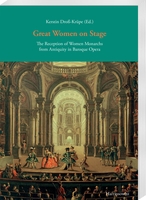|
weitere Titel zum Thema:
Download:
Bitte beachten Sie: Mit digitalen Produkten in Ihrem Warenkorb
wird die Bezahlung nur per PayPal möglich. Der Download dieser Produkte wird bereitgestellt, wenn die Bezahlung bestätigt ist. Baroque opera is entirely plurimedial. Like no other medium, it offers unique possibilities to create, transform and reinterpret common historical images and figures, using different but closely intertwined semantic levels (drama, music, acting). This makes baroque opera a promising subject of historical, political and gender-specific analysis.
The present volume is based on a session of the Eleventh European Social Science History conference in 2016 and examines the (re-)presentation of antique female rulers in baroque opera. The volume is not about music history or music theory studies, but deals with how, in the baroque period, librettists, composers and stage processed the ancient material in order to present female rulers on stage. Baroque opera is a particularly suitable model of study, as ancient themes occupy a prominent place during that period of time. Agnès Garcia Ventura and Marta Ortega Balanza focus on Agrippina the Younger as adapted in a staging of Georg Friedrich Händel’s opera Agrippina at the Liceu opera house in Barcelona in 2013. They analyze the miscellaneous gender representations of Agrippina from ancient sources to Händel’s opera and its Barcelona staging. In Valeska Hartmann’s contribution Cleopatra VII plays the lead. Hartmann focuses on the stage designs used to create an appropriate setting for this ambivalent and often highly sexualized ruler. Both case studies are preceded by an introductory chapter by Kerstin Droß-Krüpe about the opera seria as a source for the reception of antiquity and an essay by Kerstin Weiand about the polyvalence of antiquity in early modern Europe. |
|||||||||||||||||||||||||||||||||||||




